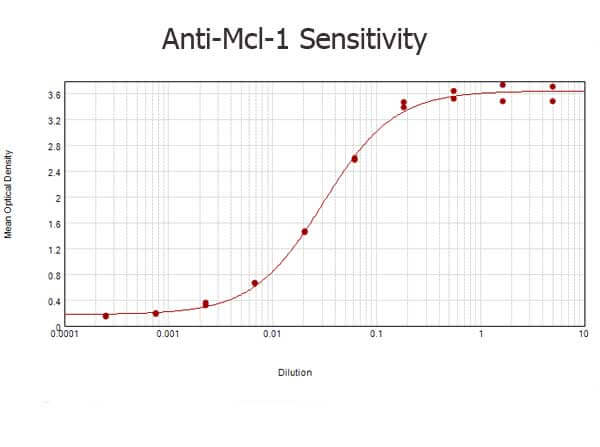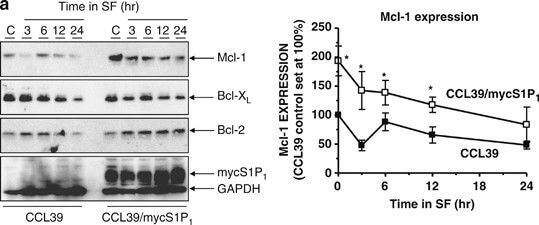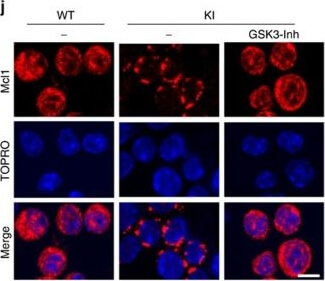Datasheet is currently unavailable. Try again or CONTACT US
Mcl-1 Antibody
Rabbit Polyclonal
85 References
600-401-394S
600-401-394
25 µL
100 µg
Liquid (sterile filtered)
Liquid (sterile filtered)
WB, ELISA, IHC, IF, FC, IP
Mouse
Rabbit
Shipping info:
$50.00 to US & $70.00 to Canada for most products. Final costs are calculated at checkout.
Product Details
Anti-Mcl-1 (RABBIT) Antibody - 600-401-394
rabbit anti-Mcl-1 antibody, Mcl1, Mcl 1, Bcl 2 related protein EAT/mcl1 antibody, Bcl2 related antibody, EAT antibody, Induced myeloid leukemia cell differentiation protein Mcl-1 antibody
Rabbit
Polyclonal
IgG
Target Details
Mcl1 - View All Mcl1 Products
Mouse
Conjugated Peptide
This affinity purified antibody was purified from whole rabbit serum prepared by repeated immunizations with a synthetic peptide corresponding to an internal region of mouse Mcl-1 conjugated to Keyhole Limpet Hemocyanin (KLH).
This affinity-purified antibody was prepared from monospecific antiserum by immunoaffinity chromatography using synthetic peptide coupled to agarose beads followed by cross adsorption to remove any unwanted reactivity. Assay by immunoelectrophoresis resulted in a single precipitin arc against anti-Rabbit Serum.
Application Details
ELISA, WB
FC, IF, IHC, IP
- View References
Anti-Mcl-1 Antibody has been tested by ELISA and western blot and is suitable for immunoprecipitation. This antibody detects mouse Mcl-1 and is not expected to cross react with the human sequence. Cross reactivity with Mcl-1 from other sources is unknown. This antibody is highly specific, showing no bands in null cell lysates from Mcl-1 knockout mice even when grossly over-exposed. Mouse Mcl-1 (myeloid cell leukemia sequence 1) is composed of 331 amino acids and is reported to be 35.2 kDa in size. The human ortholog consists of 351 amino acids and is reported to be 37.3 kDa in size.
Formulation
1.1mg/ml by UV absorbance at 280 nm
0.02 M Potassium Phosphate, 0.15 M Sodium Chloride, pH 7.2
0.01% (w/v) Sodium Azide
None
Shipping & Handling
Dry Ice
Store vial at -20° C prior to opening. Aliquot contents and freeze at -20° C or below for extended storage. Avoid cycles of freezing and thawing. Centrifuge product if not completely clear after standing at room temperature. This product is stable for several weeks at 4° C as an undiluted liquid. Dilute only prior to immediate use.
Expiration date is one (1) year from date of receipt.
Regulated apoptosis is essential for both the development and the subsequent maintenance of the immune system. Interleukins, including IL-2, IL-4, IL-7 and IL-15, heavily influence lymphocyte survival during the vulnerable stages of VDJ rearrangement and later in ensuring cellular homeostasis, but the genes specifically responsible for the development and maintenance of lymphocytes have not been identified. The Anti apoptotic protein Mcl-1 (myeloid cell leukemia sequence 1 (BCL2-related)) is an attractive candidate, as it is highly regulated, appears to enhance short-term survival and functions at an apical step in genotoxic deaths. However, Mcl-1 deficiency results in peri-implantation lethality. Mice, conditional for Mcl-1, display a profound reduction in B and T lymphocytes when Mcl-1 is removed. Deletion of Mcl-1 during early lymphocyte differentiation increases apoptosis and arrests the development at pro-B-cell and double negative T-cell stages. Induced deletion of Mcl-1 in peripheral B- and T-cell populations results in their rapid loss. Moreover, IL-7 both induces and requires Mcl-1 to mediate lymphocyte survival. Mcl-1 is essential both early in lymphoid development and later on in the maintenance of mature lymphocytes.
Linderboim L et al. (2024). LINC complex protein nesprin-2 has pro-apoptotic activity via Bcl-2 family proteins. Cell Death Discov.
Applications
WB, IB, PCA
Karbon G et al. (2024). Chronic spindle assembly checkpoint activation causes myelosuppression and gastrointestinal atrophy. EMBO Rep.
Applications
WB, IB, PCA
Pileggi CA et al. (2023). The SARS-CoV-2 spike glycoprotein interacts with MAO-B and impairs mitochondrial energetics. Curr Res Neurobiol.
Applications
WB, IB, PCA
Prucsi Z et al. (2023). Porphyromonas gingivalis Peptidyl Arginine Deiminase (PPAD) in the Context of the Feed-Forward Loop of Inflammation in Periodontitis. Int J Mol Sci.
Applications
WB, IB, PCA
Huang AS et al. (2023). Mitochondrial E3 ubiquitin ligase MARCHF5 controls BAK apoptotic activity independently of BH3-only proteins. Cell Death Differ.
Applications
WB, IB, PCA
Quarato G et al. (2023). Mitophagy restricts BAX/BAK-independent, Parkin-mediated apoptosis. Sci Adv.
Applications
WB, IB, PCA
Moyzis, AG et al. (2022). Mcl-1 Differentially Regulates Autophagy in Response to Changes in Energy Status and Mitochondrial Damage. Cells
Applications
WB, IB, PCA
Prew MS et al. (2022). MCL-1 is a master regulator of cancer dependency on fatty acid oxidation. Cell Rep.
Applications
WB, IB, PCA
Quarato G et al. (2022). Ca2+-mediated mitochondrial inner membrane permeabilization induces cell death independently of Bax and Bak. Cell Death Differ.
Applications
WB, IB, PCA
Buitrago-Molina LE et al. (2021). p53-Independent Induction of p21 Fails to Control Regeneration and Hepatocarcinogenesis in a Murine Liver Injury Model. Cell Mol Gastroenterol Hepatol.
Applications
WB, IB, PCA
Sumiyoshi M et al. (2021). Arf1 and Arf6 synergistically maintain survival of T cells during activation. J Immunol.
Applications
Undefined
Patel, P (2021). Inhibition of the Anti-Apoptotic Bcl-2 Family by BH3 Mimetics Sensitize the Mitochondrial Permeability Transition Pore Through Bax and Bak. Frontiers in Cell and Developmental Biology
Applications
WB, IB, PCA
Mizutani N et al. (2021). Gab1 in livers with persistent hepatocyte apoptosis has an antiapoptotic effect and reduces chronic liver injury, fibrosis, and tumorigenesis. Am J Physiol Gastrointest Liver Physiol.
Applications
Undefined
Chen Y et al. (2021). Ser9 phosphorylation of GSK-3β promotes aging in the heart through suppression of autophagy. J Cardiovasc Aging
Applications
WB, IB, PCA
Flemmer RT et al. (2021). The Role of Mcl-1 in Embryonic Neural Precursor Cell Apoptosis. Front Cell Dev Biol.
Applications
WB, IB, PCA
Turnis M. et al. (2020). Requirement for Anti-Apoptotic MCL-1 during Early Erythropoiesis. Blood
Applications
WB, IB, PCA; IHC, ICC, Histology
Smith KH. et al. (2020). Heme-Sensing Pathway Modulates Susceptibility of Poor Prognosis B-Lineage Acute Leukemia to BH3-Mimetics. Mol Cancer Res.
Applications
WB, IB, PCA
The CE et al. (2020). MCL-1 is essential for survival but dispensable for metabolic fitness of FOXP3+ regulatory T cells. Cell Death Differ.
Applications
WB, IB, PCA
Moyzis AG et al. (2020). Mcl-1-mediated mitochondrial fission protects against stress but impairs cardiac adaptation to exercise. J Mol Cell Cardiol.
Applications
IP, Co-IP; WB, IB, PCA
Jayavelu AK et al. (2020). Splicing factor YBX1 mediates persistence of JAK2-mutated neoplasms. Nature.
Applications
WB, IB, PCA
Djajawi, TM et al. (2020). MARCH5 requires MTCH2 to coordinate proteasomal turnover of the MCL1:NOXA complex. Cell Death and Differentiation
Applications
WB, IB, PCA
Hirsova, P et al. (2020). Hepatocyte apoptosis is tumor promoting in murine nonalcoholic steatohepatitis. Cell Death & Disease
Applications
WB, IB, PCA
Dong L et al. (2020). Glucocorticoids can induce BIM to trigger apoptosis in the absence of BAX and BAK1. Cell Death Dis.
Applications
WB, IB, PCA
Saito Y et al. (2019). DNase II activated by the mitochondrial apoptotic pathway regulates RIP1-dependent non-apoptotic hepatocyte death via the TLR9/IFN-β signaling pathway. Cell Death Differ.
Applications
WB, IB, PCA
Fogarty LC et al. (2019). Mcl-1 and Bcl-xL are essential for survival of the developing nervous system. Cell Death Differ.
Applications
WB, IB, PCA
Wang S et al. (2019). Impaired TFEB-mediated lysosomal biogenesis promotes the development of pancreatitis in mice and is associated with human pancreatitis. Autophagy.
Applications
WB, IB, PCA
Schoeler K et al. (2019). CHK1 dosage in germinal center B cells controls humoral immunity. Cell Death Differ.
Applications
WB, IB, PCA
Zhu, Z et al. (2019). The AKT isoforms 1 and 2 drive B cell fate decisions during the germinal center response. Life Science Alliance
Applications
WB, IB, PCA
Dong, L et al. (2019). In the absence of apoptosis, myeloid cells arrest when deprived of growth factor, but remain viable by consuming extracellular glucose. Cell Death and Differentiation
Applications
WB, IB, PCA
Schubert et al. (2018). Requirement of GSK-3 for PUMA induction upon loss of pro-survival PI3K signaling. Cell Death & Disease
Applications
WB, IB, PCA
Guerra et al. (2018). Precision Targeting of BFL-1/A1 and an ATM Co-dependency in Human Cancer. Cell Reports
Applications
WB, IB, PCA
Suzuki et al. (2018). Infection with flaviviruses requires BCLXL for cell survival. PLOS Pathogens
Applications
WB, IB, PCA
Tuzlak S et al. (2018). Differential effects of Vav‐promoter‐driven overexpression of BCLX and BFL1 on lymphocyte survival and B cell lymphomagenesis. FEBS J.
Applications
WB, IB, PCA
Escudero S et al. (2018). Dynamic regulation of long-chain fatty acid oxidation by a noncanonical interaction between the MCL-1 BH3 helix and VLCAD. Mol Cell.
Applications
WB, IB, PCA
Salisbury-Ruf, CT et al. (2018). Bid maintains mitochondrial cristae structure and function and protects against cardiac disease in an integrative genomics study. ELife
Applications
WB, IB, PCA
Sochalska et al. (2017). MYC selects against reduced BCL2A1/A1 protein expression during B cell lymphomagenesis. Oncogene
Applications
WB, IB, PCA
Tuzlak et al. (2017). The BCL-2 pro-survival protein A1 is dispensable for T cell homeostasis on viral infection. Cell Death & Differentiation
Applications
WB, IB, PCA
Singh et al. (2017). Dynein light chain 1 induces assembly of large Bim complexes on mitochondria that stabilize Mcl-1 and regulate apoptosis. Genes & Development
Applications
WB, IB, PCA
Girnius et al. (2017). JNK Promotes Epithelial Cell Anoikis by Transcriptional and Post-translational Regulation of BH3-Only Proteins. Cell Reports
Applications
WB, IB, PCA
Adoro S et al. (2017). Post-translational control of T cell development by the ESCRT protein CHMP5. Nat Immunol.
Applications
Undefined
Brouwer JM et al. (2017). Conversion of Bim-BH3 from activator to inhibitor of Bak through structure-based design. Mol Cell.
Applications
Undefined
Schuler et al. (2016). The BH3-only protein BIM contributes to late-stage involution in the mouse mammary gland. Cell Death & Differentiation
Applications
WB, IB, PCA
Sochalska et al. (2016). Conditional knockdown of BCL2A1 reveals rate-limiting roles in BCR-dependent B-cell survival. Cell Death & Differentiation
Applications
WB, IB, PCA
Wang et al. (2016). Increased hepatic receptor interacting protein kinase 3 expression due to impaired proteasomal functions contributes to alcohol-induced steatosis and liver injury. Oncotarget
Applications
WB, IB, PCA
Thornton et al. (2016). Inactivation of nuclear GSK3β by Ser(389) phosphorylation promotes lymphocyte fitness during DNA double-strand break response. Nature Communications
Applications
IF, Confocal Microscopy; WB, IB, PCA
Vier et al. (2016). The anti-apoptotic Bcl-2 family protein A1/Bfl-1 regulates neutrophil survival and homeostasis and is controlled via PI3K and JAK/STAT signaling. Cell Death & Disease
Applications
WB, IB, PCA
D'Orsi et al. (2016). Bok Is Not Pro-Apoptotic But Suppresses Poly ADP-Ribose Polymerase-Dependent Cell Death Pathways and Protects against Excitotoxic and Seizure-Induced Neuronal Injury. The Journal of Neuroscience
Applications
WB, IB, PCA
Lee et al. (2016). Allosteric inhibition of antiapoptotic MCL-1. Nature Structural & Molecular Biology
Applications
WB, IB, PCA
Ohmer et al. (2016). Anti-apoptotic Bcl-XL but not Mcl-1 contributes to protection against virus-induced apoptosis. Cell Death & Disease
Applications
WB, IB, PCA
Myasnikov et al. (2016). Structure-function insights reveal the human ribosome as a cancer target for antibiotics. Nature Communications
Applications
WB, IB, PCA
Goodall et al. (2016). Cycloheximide Can Induce Bax/Bak Dependent Myeloid Cell Death Independently of Multiple BH3-Only Proteins. PLOS One
Applications
WB, IB, PCA
Williams et al. (2015). Chronic Deletion and Acute Knockdown of Parkin Have Differential Responses to Acetaminophen-induced Mitophagy and Liver Injury in Mice. Journal of Biological Chemistry
Applications
WB, IB, PCA
Omari et al. (2015). Mcl-1 is a key regulator of the ovarian reserve. Cell Death & Disease
Applications
IF, Confocal Microscopy; IHC, ICC, Histology; WB, IB, PCA
Chen et al. (2015). An interconnected hierarchical model of cell death regulation by the BCL-2 family. Nature Cell Biology
Applications
WB, IB, PCA
Kleiman E et al. (2015). Distinct transcriptomic features are associated with transitional and mature B-cell populations in the mouse spleen. Front Immunol.
Applications
WB, IB, PCA
Choudhary, GS et al. (2015). Cyclin E/Cdk2-dependent phosphorylation of Mcl-1 determines its stability and cellular sensitivity to BH3 mimetics. Oncotarget
Applications
WB, IB, PCA
Ma SB et al. (2014). Bax targets mitochondria by distinct mechanisms before or during apoptotic cell death: a requirement for VDAC2 or Bak for efficient Bax apoptotic function. Cell Death Differ.
Applications
WB, IB, PCA
Choi YB et al. (2014). HTLV-1 tax stabilizes MCL-1 via TRAF6-dependent K63-linked polyubiquitination to promote cell survival and transformation. PLoS Pathog.
Applications
IP, Co-IP; WB, IB, PCA
Mahajan, IM et al. (2014). BH3-only protein BIM mediates heat shock-induced apoptosis. PloS One
Applications
WB, IB, PCA
Magiera MM et al. (2013). Trim17-mediated ubiquitination and degradation of Mcl-1 initiate apoptosis in neurons. Cell Death Differ.
Applications
WB, IB, PCA
Thomas RL et al. (2013). Loss of MCL-1 leads to impaired autophagy and rapid development of heart failure. Genes Dev.
Applications
WB, IB, PCA
Hasan SMM et al. (2013). Mcl1 regulates the terminal mitosis of neural precursor cells in the mammalian brain through p27Kip1. Development.
Applications
WB, IB, PCA
Koziel K et al. (2013). RAF and antioxidants prevent cell death induction after growth factor abrogation through regulation of Bcl-2 proteins. Exp Cell Res.
Applications
WB, IB, PCA
Gruber S et al. (2013). Obesity promotes liver carcinogenesis via Mcl-1 stabilization independent of IL-6Rα signaling. Cell Rep.
Applications
WB, IB, PCA
Rutherford C et al. (2013). Regulation of cell survival by sphingosine-1-phosphate receptor S1P1 via reciprocal ERK-dependent suppression of Bim and PI-3-kinase/protein kinase C-mediated upregulation of Mcl-1. Cell Death Dis.
Applications
WB, IB, PCA
Ouyang YB et al. (2012). miR-181 targets multiple Bcl-2 family members and influences apoptosis and mitochondrial function in astrocytes. Mitochondrion.
Applications
WB, IB, PCA
Clybouw C et al. (2012). Alternative splicing of Bim and Erk-mediated Bim EL phosphorylation are dispensable for hematopoietic homeostasis in vivo. Cell Death Differ.
Applications
WB, IB, PCA
Malone CD et al. (2012). Mcl-1 regulates the survival of adult neural precursor cells. Mol Cell Neurosci.
Applications
WB, IB, PCA
Selimoglu-Buet D et al. (2012). Oncogenic kit triggers Shp2/Erk1/2 pathway to down-regulate the pro-apoptotic protein Bim and to promote apoptosis resistance in leukemic cells. PLoS One
Applications
WB, IB, PCA
Du H et al. (2011). BH3 domains other than Bim and Bid can directly activate Bax/Bak. J Biol Chem.
Applications
IP, Co-IP; WB, IB, PCA
Kinross KM et al. (2011). In vivo activity of combined PI3K/mTOR and MEK inhibition in a KrasG12D; Pten deletion mouse model of ovarian cancer. Mol Cancer Ther.
Applications
WB, IB, PCA
Mavrakis KJ et al. (2011). A cooperative microRNA-tumor suppressor gene network in acute T-cell lymphoblastic leukemia (T-ALL). Nat Genet.
Applications
WB, IB, PCA
Malin S et al. (2010). Role of STAT5 in controlling cell survival and immunoglobulin gene recombination during pro-B cell development. Nat Immunol.
Applications
WB, IB, PCA
Yuan J et al. (2010). c-Myb promotes the survival of CD4+ CD8+ double-positive thymocytes through upregulation of Bcl-xL. J Immunol.
Applications
WB, IB, PCA
Zhang J et al. (2009). Mitophagy in mammalian cells: the reticulocyte model. Methods Enzymol.
Applications
WB, IB, PCA
Masuoka HC et al. (2009). Mcl-1 degradation during hepatocyte lipoapoptosis. J Biol Chem.
Applications
WB, IB, PCA
Whitecross KF et al. (2009). Defining the target specificity of ABT-737 and synergistic antitumor activities in combination with histone deacetylase inhibitors. Blood.
Applications
WB, IB, PCA
Hikita, H et al. (2009). Mcl-1 and Bcl-xL cooperatively maintain integrity of hepatocytes in developing and adult murine liver. Hepatology (Baltimore, Md.)
Applications
WB, IB, PCA
Hikita, H et al. (2009). BH3-only protein bid participates in the Bcl-2 network in healthy liver cells. Hepatology (Baltimore, Md.)
Applications
WB, IB, PCA
Callus BA et al. (2008). Triggering of apoptosis by Puma is determined by the threshold set by prosurvival Bcl-2 family proteins. J Mol Biol.
Applications
WB, IB, PCA
Dzhagalov, I. et al. (2008). The anti-apoptotic Bcl-2 family member Mcl-1 promotes T lymphocyte survival at multiple stages. Journal of Immunology (Baltimore, Md. : 1950)
Applications
FC, FACS, FLOW; WB, IB, PCA
Huntington ND et al. (2007). Interleukin 15–mediated survival of natural killer cells is determined by interactions among Bim, Noxa and Mcl-1. Nat Immunol.
Applications
WB, IB, PCA
Schweers RL et al. (2007). NIX is required for programmed mitochondrial clearance during reticulocyte maturation. Proc Natl Acad Sci USA
Applications
WB, IB, PCA
Deng J et al. (2007). Proapoptotic BH3-only BCL-2 family protein BIM connects death signaling from epidermal growth factor receptor inhibition to the mitochondrion. Cancer Res.
Applications
WB, IB, PCA
Kupumbati TS et al. (2006). Dominant negative retinoic acid receptor initiates tumor formation in mice. Mol Cancer
Applications
IHC, ICC, Histology
This product is for research use only and is not intended for therapeutic or diagnostic applications. Please contact a technical service representative for more information. All products of animal origin manufactured by Rockland Immunochemicals are derived from starting materials of North American origin. Collection was performed in United States Department of Agriculture (USDA) inspected facilities and all materials have been inspected and certified to be free of disease and suitable for exportation. All properties listed are typical characteristics and are not specifications. All suggestions and data are offered in good faith but without guarantee as conditions and methods of use of our products are beyond our control. All claims must be made within 30 days following the date of delivery. The prospective user must determine the suitability of our materials before adopting them on a commercial scale. Suggested uses of our products are not recommendations to use our products in violation of any patent or as a license under any patent of Rockland Immunochemicals, Inc. If you require a commercial license to use this material and do not have one, then return this material, unopened to: Rockland Inc., P.O. BOX 5199, Limerick, Pennsylvania, USA.



















